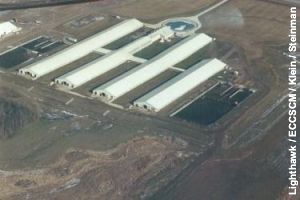Facing Problems with an Existing CAFO? Organize Community Members to Help Stop CAFO Pollution
How do you stop CAFO pollution in your community? You become a loud, squeaky wheel. This page helps you learn how to bring your neighbors and community together to fight CAFO pollution.
A. Identify Who is Affected by the Pollution
Many people who live near a CAFO are unable to go outdoors, have picnics, hang laundry, or mow the grass—the stench and adverse health effects from CAFO pollution are that bad. They end up becoming prisoners in their own homes, while at the same time their property values plummet, and their drinking water becomes contaminated.
If you have a CAFO in your community, this is probably familiar. Talk to your neighbors and friends and bring those together who are affected by the CAFO, both directly and indirectly.
- Speak with those who live nearest the facility, and talk with landowners next to the fields where the CAFO waste is applied.
- Both the very young and the elderly have probably been affected by CAFO pollution. Talk to parents, senior citizens, and others who may have seen adverse health conditions from the CAFO's presence.
- People with sensitive immune systems are directly affected by the CAFO’s gases, emissions,and pollution discharges to water, land and air.
- Local family farmers are often run out of business, or their farms suffer because of the CAFO. CAFO operators often offer family farms more money to rent land but do not practice good stewardship. CAFO operators are notorious for overapplication of waste, which causes poor field crops, and for irrigating in such large quantities that they have to keep reseeding a field. They never intend to harvest a crop; they'll only use this type of field for waste disposal.
B. Bring CAFO Neighbors Together
The people you speak with will want to know what they can do to fight the CAFO near their homes, parks, and schools.
Organize a plan for fighting the CAFO:
- Meet with the concerned neighbors on a regular basis, maybe in someone’s home or at the local library or community center.
- Ask the group if they want to form a nonprofit to help rally support from others.
- Give each other support and share information regularly. Regular meeting times, as well as an email list, is a good way to keep people involved.
- Have everyone in your group read the CAFO's NPDES permit and their Comprehensive Nutrient Management Plan (CNMP), so that you are familiar with the requirements. Many CAFO activities are not necessarily illegal - but the only way to know is to familiarize yourself with their NPDES permit. You can get copies of the documents from the MDEQ through the Freedom of Information Act.
- Keep track of any health impacts the group observes in friends and families that may be caused by water or air pollution.
- Before the animals come in, do baseline testing in the surface water around the CAFO facility and the fields where manure will be spread, using the water monitoring protocol. See conducting water testing.
- Get drinking wells tested within a mile of the facility. Have wells regularly tested to track any changes that might be due to the CAFO’s spreading of animal waste on the land. You may already be doing this if you or a member of your group has been creating a CAFO layout or conducting water testing.
- Note any road damage the CAFO causes by trucking waste to fields, and notify your township or county road commission.
- Keep track of any socioeconomic impacts to the community; for example: decreases in property values, businesses that close, loss of small farms in the community, decrease in population (thus the tax base).
- Compile and share all the information you’ve documented to help educate the community, local officials, and your state representatives.
- Prepare and submit comments for the CAFO’s NPDES water discharge permit application, and request a public hearing. If they already have a NPDES permit, then at some point they will need to renew that permit, and you can comment on that renewal, too.
- Reach out to the media to help raise awareness of the problem.
- Ask for help from others who are experienced at fighting CAFOs.
And, if you haven’t already, create a layout of the CAFO. You and other concerned citizens should track and document everything you observe.
Next, report the CAFO's illegal behavior to regulatory agencies.
Also see How To Stop Approval of a New CAFO
